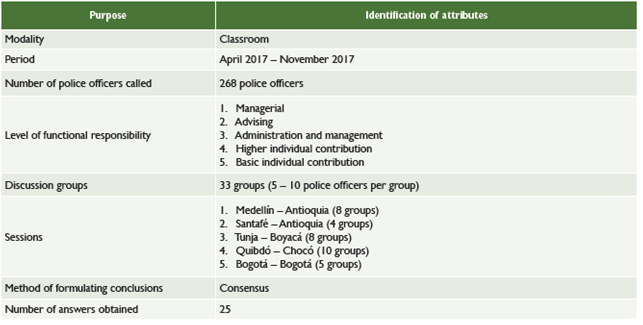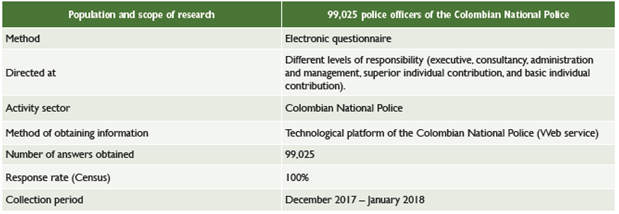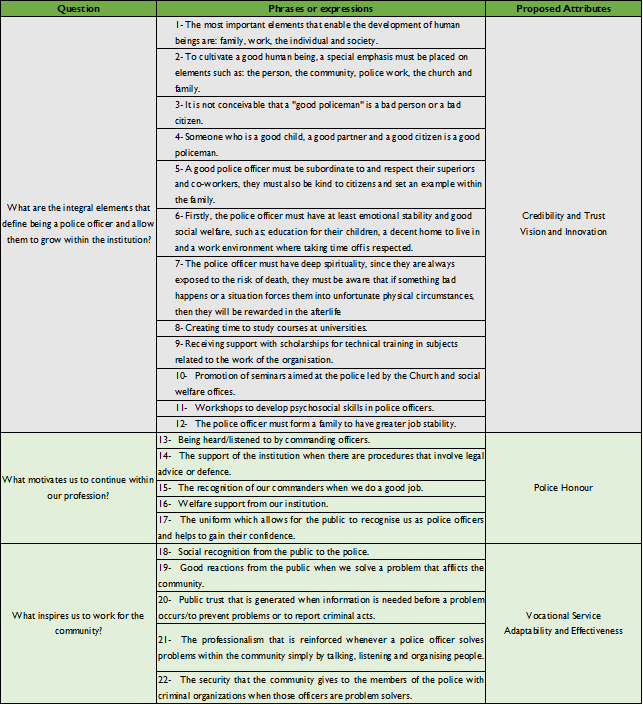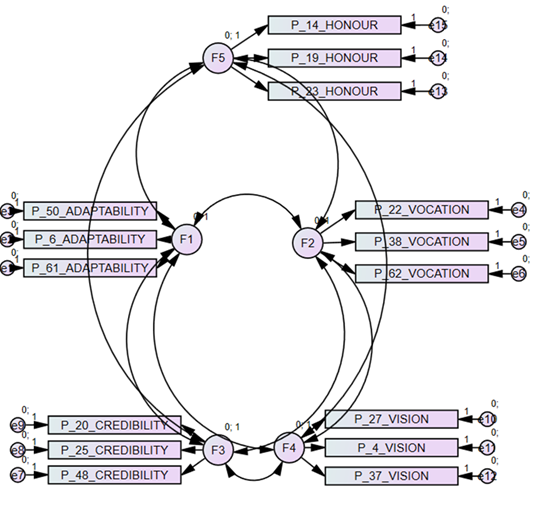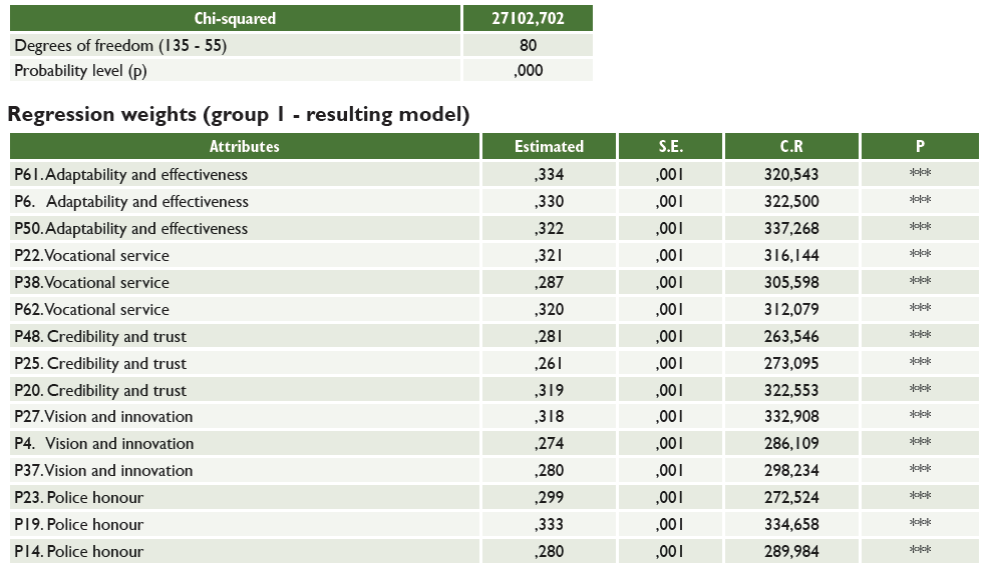Introduction
This study aims to identify the attributes of police leadership and how that relates to the to be, to know, and know-how of a police officer. Institutional culture is a fundamental component of Human Talent Management and is therefore an important vehicle in meeting the objective of the study. The primary mission for Talent Management is to ensure a high-quality service for personnel, strengthening dignity in their role expressed through mutual respect, professional/personal balance and nurturing assertive behaviour amongst its officials, all of which help to meet the established objectives. To this end, police leadership is identified as a necessary tool to mobilize the will of personnel and achieve greater effectiveness in the provision of police service (Nieto, Nieto & Moreno, 2018).
The Colombian National Police analysed the different behavioural aspects of the police service. Using that data, they were able to define leadership as a set of skills required by police officers for their effective development; however, it is a subject that had not been integrally incorporated within the police, nor did it have any unifying criteria within the institution. This led to the creation of the question that underpins this research study: What are the attributes that best identify the to be, to know, and know-how of a police leader?
This study is based on a theoretical, conceptual and practical review of the main studies and developments regarding leadership as a means of defining those attributes that a police leader should have. The attributes are those qualities that support the required skills to develop their thinking and behaviour, achieving coherence between what is thought, said and done (Acosta-Prado, Zárate, & Garzón (2015).) This will allow for the development of a police leader who can understand, value and guide subordinates, as well as inspire and develop other leaders, achieving high levels of performance in the areas where they interact (Nieto, Nieto & Moreno, 2018).
To identify the attributes of the police leadership; the environmental conditions, cultural differences and the generational gaps within the National Police are considered. This is an organisation where more than 180,000 officials (police officers and civilian personnel) interact, and the study looks to harness the key attributes to better develop their effective leadership skills.
The empirical study was conducted in two sequences. Firstly, qualitative techniques were used to identify the attributes of the police leader, then quantitative techniques were applied to validate the presence, coherence, and relationship of those attributes within the uninformed personnel.
This article is structured as follows: first, the theoretical foundation and hypothesis are established; second, a general description of the methodology used for the empirical study is outlined, specifically, the techniques and instruments used for the collection and analysis of data and their application within the Colombian National Police; third, the results obtained from the empirical study are explained and, finally, the final considerations and conclusions of the study are presented.
Theoretical foundation and hypothesis
Traditional leadership figures are understood to be heroic, charismatic individuals with hierarchical power, who can motivate followers, focused on differentiating success and failure through productivity and the way in which their command influenced the laborers (Luthans, 2008). However distributive and shared leadership also exists, where the leader may not be at the helm of the organisation, but they are someone who directs the culture and generates situations of satisfaction, happiness and success within their team (Nieto, Nieto & Moreno, 2018; Guerrero, 2012; Zárate & Acosta-Prado, 2012; Fiedler, 1967, 1971).
According to Godin (2008), today’s leader assumes responsibilities, knows what they want and where they’re heading, understand that they cannot achieve success without directing those people they call "tribes", to whom they must give the necessary tools to make things happen.
In turn, Cattell (1951) highlights the term ‘group syntality’, which means that any member of a work team can be a leader, each one establishes their own responsibility, makes decisions, organizes their tasks, etc. In this sense, characteristics such as authority, execution of work, role differentiation, group interaction, the process of influences, the addressing and responsibilities model, guide and shape an ideal efficient leader without being endowed with a formal authority addressed to their will, but that influences the attitudes and opinions of their workers (Contreras & Barbosa, 2013, Waldman, Ramírez, House & Puranam, 2001, Katz & Kahn, 1985).
According to the International Association of Chiefs of Police (IACP) (2006), leadership is defined as a process capable of influencing human behaviour, with the purpose of achieving the goals of this public-serving organisation and at the same time developing people, groups and organisations for the future evolution of the service. Trust is highlighted as one of the fundamental elements to the service for the community and its institution.
Therefore, a leader must be able to mobilise the will of others towards the achievement of common objectives (personal and organisational). These objectives are considered to be caring about employee needs, interest in getting the best out of people, identifying their best virtues and skills for the benefit of the organisation, with the ability to contribute to the goals according to their level of responsibility, ability to adapt to the rapid changes that expose them to new missions, complex situations where the level of performance should be higher and in dynamic environments. These objectives refer to all those external factors that can have a significant influence on the strategy and that the organization cannot control (Acosta-Prado, 2012).
As mentioned in the literature review, there is evidence of the multiplicity of theory, models, perspectives, and implications on leadership. Hence, in this study, those theoretical and empirical aspects related to leadership in the police service are taken as a reference for the model, theories and implications. For its part, in the participatory leadership model developed by Vroom & Yetton (1973), which is based on decision-making, the authors argue that the most appropriate style of leadership must be chosen for each situation (Amorós, 2007, García, 2015).
In this way, the interactionist model emphasises the behaviours and attitudes of workers as determining the ultimate performance of the leader (reciprocity between leader-followers). This interaction would explain the two types of leadership that Hunt, Osborn, & Schuler (1978) describe, as follows: the discretionary (situation under the power of the leader) and non-discretionary (the leader responds to the demand of his workers). This type of leadership is an evolutionary process product of learning.
In addition, the idiosyncratic credit model establishes that the leader and his subordinates develop a kind of psychological contract. Under this model, the leader manages to influence the members of the group, obtaining esteem, status, and trust (credits), as well as providing subordinates with valuable resources for the acquisition of attainments as a work team (Hollander & Julian, 1969).
Also, the attribution of leadership model, based on covariation and causal schemes from Kelley (1973), states that the generated behaviours stem from internal factors, namely, within the control of the person. If they are external factors, that is, within their environment, three determining attribution factors are established: distinctive (a person who responds differently in different situations), consensus (a person who responds in the same way to similar situations) and consistency (a person who responds in the same way despite the time elapsed). Finally, the error of fundamental attribution is highlighted, which refers to the bias of self-benefit as an aspect that intervenes at the time that an individual makes judgments to others (Amorós, 2007).
By contrast, the implicit theories developed by Lord, Foti & De Vader (1984) and Rosch (1978), describe leadership from a categorisation process, although it is not exact, where reference is made to beliefs and values about the behaviour of the ‘ought to be’ and ‘doing’ considered by a leader. For this, the attributional process is presented, which allows for the categorisation of the ideal leader, identifying their behaviours and determining their stimuli and their relationship with the workgroup (Castro & Lupano, 2005).
The situational theory of Hersey-Blanchard (1967) is a dynamic focused on the evolution of the learning of members of the work team. Their results are seen in the long term, with a commitment to the process and competence levels must be demonstrated. This is a process of personal development and, in turn, generates progress within the organization; that is to say, the effectiveness of the leaders will depend on their employees accepting or rejecting it. The ideal form of leadership is considered when determining the influence, direction, and support of leaders towards members of the work team rather than towards authority. Situational leadership focuses on employees and is successful as long as they have the ability and willingness to select the right style for a particular task and situation, allowing them to define roles and point out to people what, how, when and where tasks must be performed, thereby providing a supporting directive behaviour and decision-making (Amorós, 2007).
Meanwhile, Blake & Mount (1964) present an administrative theory called "Managerial Mesh" which seeks to relate professional efficiency with individual satisfaction levels, making all employees participate according to their hierarchical level. Two basic dimensions are established: interest in production and interest in human factors. A type of leadership is located within these dimensions according to the high or low level of interest in each of them, that is to say, those who show low levels of interest in accomplishing the task but maintain good relations with their team members is considered as Country Club. Another type of leadership is ‘authority-obedience’, where there is only interest in undertaking the tasks, not in interpersonal relationships. On the other hand, management oriented on the organisation and the individual, poor management and team management are also exposed (Franco & Zapata, 2013).
When analysing the different theories of transformational, transactional, behavioural, trait or personality, implicit, interactionist and situational approach leadership, the 3D Theory is presented as a three-dimensional model from the University of Ohio, developed by Reddin (1983).
This theory develops concepts such as adaptability, understood as the effectiveness with which the person adapts or imposes themselves on situations. Every person has a set of behaviours when confronted by reality; their adequate management and how to harness them for deployment during the situation allows them to be perceived as adaptable people (Reddin, 1989). A second concept is that of effectiveness under pressure: understanding how the person behaves in high-pressure situations. Some people have lower effectiveness under high pressure, others become more effective under high levels of pressure. Then there is structural need: when the person needs to rely on the formal power structure of their organisation or personal power in order to exert an influence. Finally, there are competences dominated by managers, according to the specifications of the institution (Reddin, 1983).
Based on these concepts, leadership is established through two basic elements of behaviour. On the one hand, task orientation (TO), which is the degree to which a person directs their own efforts and those from their work team towards the completion of a task, has the ability to interact with others and, at the same time, allows them to move based on given orders, giving precise instructions and pointing out the performance standards expected from others. Then there is the relationships orientation (RO), as illustrated by a person who creates an atmosphere of trust and mutual understanding within its work team as an element of influence. Based on this, a cohesive response can be given by the person who is looking to be influenced. This is basic behaviour that the person uses to move within the role with which they have been entrusted.
These behaviours can be presented in different ways, generating four types of style. If the individual exercises the two behaviours of TO and RO, then they will present an "integrated" style. If they have both of these behaviours at a low level, it means that they have no particular preference to either and would be considered to have a "separate" style. Whilst a "dedicated" style would be used to define someone with more TO than RO and a "related" style for an individual with more RO than TO. Both orientations allow for general referencing to characterise the type of behaviour before it is contextualised and identifying high and low levels of effectiveness (Nieto, 2018).
Attributes of Police Leadership
An attribute is defined as the set of characteristics that a leader should ideally possess, which must influence their relationships during their working day and in the fulfilment of their tasks (Acosta-Prado & Zárate, 2017; Mascaray, 2011). Therefore, for the Colombian National Police, attributes are defined as those essential qualities or properties that constitute the necessary competence for police leadership (Nieto, 2018, Acosta-Prado, Zárate & Pautt. (2015).
The purpose of taking as reference the different theories, models and implications on leadership, is to correctly identify the attributes, based on the Management Model of Human Talent and Institutional Culture adopted by the National Police (National Police of Colombia, 2007, Resolution No. 01087, 2019). These inputs provide clarity in the identification, differences and understanding of the attributes of the political leader and their relationship with the associated behaviors. Thus, leadership is understood as "The ability to guide and direct teams to achieve common objectives" (National Police of Colombia - MGH9C, 2007). The correct application will determine the degree of effectiveness (Acosta-Prado & Longo-Somoza, 2013).
Therefore, the generic competences grant the police profession and pretend to be inputs to ensure the success of the employees, outstanding behaviors and continuous improvement of the police service at the national level (Resolution No. 01087, 2019). In this way, the officer in the fulfillment of its responsibilities must be able to intelligently manage its breadth of repertoire of leadership styles, in order to ensure highly effective performance (Nieto, Nieto & Moreno, 2018).
These behaviors resulting from generic competences are related to the mission and performance of police work, which, in turn, are differentiating attributes of the institution. To recognize the attributes, first it is necessary to understand the dimensions of to be, to know, know-how, and know to be of the police service. (Resolution No. 01087, 2019, art. 3):
Dimension of To Be: values, personality traits, attitudes and interests that the member of the Institution should be from an ethical perspective in his role as public servant.
Dimension of To Know: specific knowledge for the performance of each load in particular, and the characteristics of the Institution in general, as well as the experience acquired through the police service.
Dimension of Know-How: skills, aptitudes and skills for the execution of political work at the administrative, teaching and operational levels.
Dimension of Know To Be: skills that the police officer possesses to develop a load with dexterity applying his experience and knowledge, as the conditions of the environment.
Having the four defined dimensions (to be, to know, know-how, and know to be), and that the police service is subject to changing social, economic, political, technological, criminal and institutional scenarios, are identified the attributes of the police leader (Nieto, Nieto & Moreno, 2018; Nieto, 2018)
Police Honour
This is the ethical and moral quality of the police leader, that guides his personal and institutional actions. It allows for the promotion of behaviours and attitudes associated with being a police officer. It is drawn from a broad approach, informed by the social and moral environments in which it is developed, and which are socially appropriate, because the police officer has a role as a guarantor of rights and is obliged to be an exemplary citizen. In this way, they will achieve the necessary social acceptance and acknowledgement of the community for which they provide the service.
Police honour refers to the fact that each police officer can feel and is able to directly convey their pride in their actions and in the police profession, avoiding any deterioration to their professional police and personal dignity starting from the principle that their actions have legal, ethical and moral foundations based on honesty, rectitude and consistency. In short, it is the ethical and moral quality of the police leader that guides their actions, personally and within the institution.
This attribute should not be understood as being or limited to the interest of managing and reflecting an acceptable image to others; it is about each police officer assimilating and reflecting their individual principles and values, which together are part of the basic doctrine and the essence of police work. This leads to the institution and its officers being well positioned, with high levels of credibility, proximity, integrity and effectiveness.
Vocational Service
A voluntary and conscious behaviour whereby the police officer can externalise their preference and passion for police work through the service that they provide. At its heart is the fact that each member of the institution should provide a good service to the public and at the same time is able to behave assertively in their day-to-day work and in their inter-personal relationships with co-workers. This vocation is reflected in the way in which they provide a good quality service to others, demonstrating the best of their human condition as a person and as a public servant. Those police officers with that conviction and the impetus to work within the service, then it is said that they have a police vocation. To that end, this attribute consists of an inner calling that leads to a good attitude during the undertaking of police service, i.e., the key driver is the desire to serve others.
Credibility and Trust
Two complementary attributes that reflect the golden rule for personal relationships and which affect both the perception of service and the level of its social acceptance and institutional legitimacy. The combination of these two behavioural characteristics results in a leader who performs their work in a timely and precise manner, thereby receiving recognition and acceptance as a police authority.
Credibility and trust are understood as supporting qualities for leadership. People tend to value leaders more, as they secure their position through a series of good results obtained over a passage of time, than the level of responsibility or relative position in the institution. A leader’s conduct and performance will lead to them earning the respect of others.
Each police officer within the force is equipped with the necessary elements to generate credibility and trust in the people, providing they act with transparency, righteousness, responsibility and professionalism, are coherent in what is thought, said and done.
Adaptability and Effectiveness
This attribute allows the police leader to adjust their thinking, behaviour and their methods of directing and influencing in order to benefit productivity within the institution.
Viewing adaptability and effectiveness as a single attribute allows the police leader to identify the most convenient leadership style for use in a specific situation. It represents the way in which police leaders need to respond to the demands of their job with versatility and intelligence, in order to generate the required results with optimal effort.
The impact of this attribute is reflected by changes in the mentality and actions of leaders within the Colombian National Police, focused on modifying their behaviours to develop greater adaptability and developing the capacity to solve problems, make high-stake decisions and demonstrate effectiveness whilst undertaking those processes that fall within their responsibility. It also allows for the correct management and direction of their work team in order to meet their proposed objectives.
Vision and Innovation
This attribute provides police leaders with the ability to understand and meet challenges within the institution in a forward-thinking and innovative fashion. It’s a particularly significant attribute for the institution as it is one of the mainstays of its ongoing process of modernisation and transformation, as it looks to provide a better service, secure greater peaceful cohabitation and coexistence and protect citizen security particularly considering any new security challenges that may arise.
The police leader must be able to reinvent themselves according to the needs of the institution needs and other social factors. Therefore, it is an attribute that is inextricably linked to a vision of the future - helping leaders to predict where changes might need to be made and generating ideas that contribute to the doctrinal, functional and operational evolution of the institution, guaranteeing its sustainability and competitiveness, thereby reinforcing and strengthening the police service. The visionary and innovative police leader has the chance to not only fulfil their own professional duties, but also to provide an effective service to the community.
Based on the literature review and the descriptions of the attributes of a police leader, the following hypothesis is established:
The attributes -police honour; vocational service; vision and innovation; adaptability and effectiveness; credibility and trust- are related direct and strongly with the dimensions of to be, to know, know-how, and know to be of the police officer.
Methodology
In order to achieve the research objective and satisfy the proposed hypothesis, an empirical study of personnel within the Colombian National Police was undertaken.
The Colombian National Police is an armed force with a civil focus, charged with maintaining public security (Political Constitution of Colombia, 1991, art. 218). The police officer is the citizen in charge of protecting the community, their function is crime prevention and addressing any illegal or illicit activity. The tasks carried out are aimed at safeguarding legality and, therefore, it is crucial that their conduct is strictly governed by current regulations (Law N° 62, 1993, art. 1 and 5).
To avoid bias in the data, the empirical study was conducted using police officers from the institution, as they share distinctive characteristics that allow us to identify the attributes of a police leader with greater certainty.
The empirical study was carried out in two sequences. Qualitative techniques were used to identify the attributes of the police leader and, at the same time, quantitative techniques were applied to validate the presence, coherence and relationship of the attributes with the to be, to know, and the know-how of the police officers.
For this study, the approach was sequential. First, qualitative data was collected and analysed, which then supported the collection and interpretation of quantitative data (Creswell, 2014). The method of data collection is of a sequential exploratory nature (DEXPLOS) with a derivative modality: a theoretical-conceptual foundation was constructed, and qualitative data was obtained in focus groups (first tool) and, then, quantitative data was obtained from the results of a survey on the institutional climate (second tool), with the purpose of guaranteeing a representative sample for the validation of the police leader's attributes. In addition, the data obtained were encoded to guarantee the confidentiality of the answers and the anonymity of the participants.
Exploratory sequential mixed methods are the reverse sequence from the explanatory sequential design. In this study the exploratory sequential approach, first we begin with a qualitative research phase and explores the views of participants. The data are then analysed, and the information used to build into a second, quantitative phase. The qualitative phase is used to build an instrument that best fits the sample under study, to identify appropriate instruments to use in the follow-up quantitative phase, or to specify variables that need to go into a follow-up quantitative study. Challenges to this design reside in focusing in on the appropriate qualitative findings to use and the sample selection for both phases of research.
The workflow was focused in three stages. First, validity evidence was collected based on the content of the test, using the focus groups criterion. Second, to provide evidence of validity based on the internal structure of the scale, was used a one-dimensional descriptive analysis of frequencies and percentages with the obtained results of the applicate survey. Finally, was used a multivariate analysis with structural equation modeling - SEM, for testing the proposed relations. (American Educational Research Association, American Psychological Association, and National Council on Measurement in Education, 2014).
There is a clear lack of measurement instruments on the leadership and the distinctive attributes of the police service. The instruments found about leadership are applied in contexts and activities different from the police service. In this sense, the empirical study was relied on with own instruments of the Institution that allowed to measure the identification of the attributes of the police leader through its relationship with the dimensions (to be, to know, know-how, and know to be), established and defined in the management model of human talent and institutional culture of the national police.
The first instrument used were the "Focus Groups", as shown in Table 1. The purpose of these groups was to identify the attributes of the police leader. The modality was face-to-face, and the sessions were held between April - November 2017. 268 police officers of different ranks and responsibilities were called to attend 33 groups (5-10 police officers per session).
At the beginning of the session the participants were informed about the phases and method of collecting information, the objectives were defined, and the questions were outlined. Each group had selected members with similar characteristics. A secretary was appointed, and the moderator carefully explained the topics for analysis and the rules that needed to be followed, in order to ensure an atmosphere of respect and cordiality during all the stages of the discussion and, specifically, the presentation of ideas.
The second process was a survey called "Institutional Climate Survey", with the purpose of validating those attributes identified during the focus groups and their relationships, associated with the dimensions of to be, to know, know-how, and know to be of the police officer.
This survey has been implemented since 2012 and plays a central role within the institution as it is seen as a facilitator to improve the working environment, contributing to productivity, motivation, and job satisfaction. This accompanied by the adequate implementation of high-quality work programs and good standards within personal/family life enhance the competencies and benefit the service by ensuring optimal behaviour either individually or in groups.
The population being studied is 99,025 police officers, embracing all levels of functional responsibility. Due to the mandatory nature of the tools, data collection was carried out via census, applied to all levels of responsibility, including executive, advisory, administration and management, superior individual contribution, and basic individual contribution. The method applied was an electronic questionnaire via the Colombian National Police’s web service platform. The data collection period was December 2017 to January 2018, as shown in Table 2.
The statistical software SPSS v25 was used to collect and process the survey data.
Once the sample data was collected, it was analysed. To that end, 15 elements that measure the "Attributes" were selected. The statistical analysis yielded a Crombach's alpha of 0.956. Therefore, the scale is reliable and there is intercorrelation among the variables that make it up (Crombach, 1951). The sample adequacy measure of Kaiser-Meyer-Olkin (KMO) is 0.950. Barlett's sphericity test (χ2 = 14320.116; GL = 1431 y p = 0.000) rejects the null hypothesis of no significant correlation among the observed variables.
Results
Once, the two sequences had been carried out, the following results were obtained. In the first sequence, corresponding to the application of the qualitative technique "Focus Groups", 22 answers or consensual conclusions were consolidated, derived from the 33 groups, the results of which are described below in table 3.
In the second sequence, as mentioned below, the different components were adapted and validated according to the police population. In addition, a reduced version of the institutional climate survey was generated, made up of 25 statements, where 15 items describe the factor "attributes".
For the collection and processing of the collected data, the statistical software SPSS v25 was used for 99,025 police officer records. Below, the reliability analysis for each factor and, in general, all the elements to the questionnaire are shown.
To corroborate whether the reliability indices of the test were met in each of the evaluated factors, we performed an Alpha Cronbach analysis correlation measure among those variables that are part of the scale. The alpha coefficient is shown in the summary table, with a reading of 0.969 demonstrating that the precision coefficient is good for the 15 items that measure the factor "attributes".
Table 4. Reliability (Cronbach's Alpha) of the Factor Attributes

Source: Elaboration with data obtained from the SPSS.
Then, a one-dimensional descriptive analysis of frequencies and percentages was carried out for each attribute, where a value greater than 80% was detected in each attribute. Next, a multivariate analysis was performed. For the analysis and validation of the attributes, relationships between the descriptor variables, which make multiple linear regression modelling difficult was taken into consideration. In addition, some of the variables considered as possible descriptors for responses of interest can reflect an underlying factor or latent variable, which allows for the testing and comparing of theories, based on the identification of the schema of the analysis component of the constructions.
Latent variables related to ‘attributes’ and constructed from observed variables are included in the study. Therefore, the model is re-specified, determining that the same variable cannot be allowed to be a part of two different factors. We then move on to the creation of a scenario whereby those variables that are part of the components are eliminated.
We then analysed and grouped the variables that make up each ‘attribute’ factor using the AMOS component of the SPSS v25 software. The resulting model is shown in Figure 1.
The result shows an identified model. A model is identified if the parameters can be estimated using the elements of the covariance matrix of the observable variables. The software also provides a list of possible relationships that are not specified.
As in any process of statistical modelling, it is essential to understand the related theory, as it is from where the validation of realistic hypotheses will arise. The next steps will allow for the addition of exogenous latent variables to the holistic model.
The development of this model contributed greatly to determining the importance of including exploratory data analysis, classification analysis and grouping, prior to the construction of any structural model confirming the theory.
For the verification of the models, the values of the coefficients obtained from the corresponding variables of the factor, the individual reliability R2 and the measures of ‘how well fitted’ it was were taken. Below, the resultant model and the statistical values of the structural equation are shown.
The results found different variables were important factors in the composition and that there were significant covariances between the factors, which confirm the construction of the theoretical model in terms of defining the relationships between the attributes.
We therefore defined those attributes identified for police leadership as: police honour; vocational service; vision and innovation; adaptability and effectiveness; credibility and trust - all of which are related to the to be, to know, and know-how of the police leader. Therefore, based on the theoretical foundation and the empirical study that was carried out, the proposed hypothesis is accepted, and the null hypothesis is rejected.
Final considerations
The proposed identification of the attributes of police leadership enabled a review including academic and empirical studies in order to establish the theoretical foundation of the study.
When analysing the different theories of leadership: transformational (Burns, 1978), transactional (Bass, 1990), trait or personality (Yukl, 1981), implicit (Lord, Foti & De Vader, 1984; Rosch, 1978), interactionist (Hunt, Osborn and Schuler, 1978), and situational (Hersey-Blanchard,1967). We observed that the police leadership have singular elements not similar with others activities of public-serving. Finally, the 3D Theory is presented as a three-dimensional model from the University of Ohio, developed by Reddin (1983) that can adapt to police service to identify with precision the attributes of police leader.
As the "attributes" identification had not been previously realized, the review was conducted with the aim of discussing its application as part of an empirical study using members of the Colombia National Police, thereby addressing any limitations and gaps in the existing literature. Therefore, it was considered appropriate to include a practical dimension within the research.
The proposed identification was characterised by the attributes of police honour; vocational service; adaptability and effectiveness; credibility and trust; vision and innovation, which were identified and validated in the two sequences of the empirical study. The first, using qualitative techniques in the "focus groups", and the second with the application of the quantitative “Institutional Climate Survey", where the presence, validation and significant relationship was confirmed following the analysis of structural equations. According to the results of the structural equation, the "attributes" construction shows a greater significance for the variables at the heart of its composition, with significant covariances between the factors. This confirms the construction and validation of the theoretical model, and the relationships between the attributes. Therefore, the objective of the study is achieved, the null hypothesis is rejected, and the proposed hypothesis is accepted.
As a result of the findings of the study, a graphic representation of the analysis has been proposed to identify the attributes of police leadership and establish the relationship between them.
This model will provide a blueprint for future studies where additional factors can be included within the model. To this end, it has been deemed appropriate and convenient to explore the relationship between the different factors associated with the leadership styles and levels of functional responsibility within the police service in order to provide a more robust and consistent analysis of the observed variables. Therefore, it is opportune to analyse the assimilation and relationship between the construction as critical components to measure and relate them to the effectiveness of police leadership.
It is also important to highlight that these attributes have been defined as a five-axes construction: police honour; vocational service; adaptability and effectiveness; credibility and trust, vision and innovation. These axes can be represented in the form of a temporary loop from recognition to appropriation. A potential future approach would be to study the process of development of the attributes from a temporal perspective. An expansion of the stratification of the population sample of uniformed police officers has therefore been proposed to better analyse the relationship between different levels of responsibility and different leadership styles. This will give greater consistency to the analysis of the institutional outcomes of the Colombian National Police.













